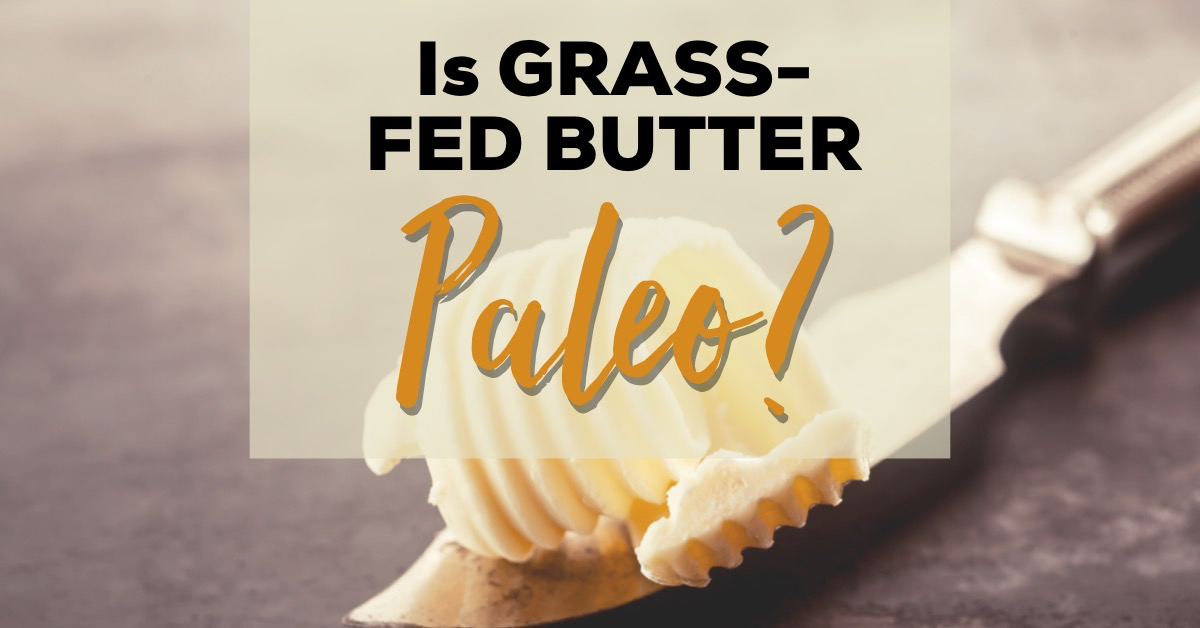
It seems in recent months there’s been a trend of Paleo eaters incorporating some non-Paleo foods, like grass-fed butter, into their diets. With the increase in popularity, it has many people wondering if grass-fed butter is actually Paleo or not. We nutritionists here at Paleo Plan wanted to hash things out to give you a clearer picture and to help you decide if your Paleo diet should include grass-fed butter or not.
The best part of Paleo, in my opinion, is how truly customizable it is. There is no one size fits all approach, and what works for someone doesn’t have to work for anyone else. Still, there are basic principles of the Paleo diet, and they are generally that grains, legumes, and dairy products are excluded because of the way that they can influence and affect the digestive system. Many people don’t tolerate them well, and Paleo is all about optimizing digestion and gut health, which in turn, optimizes total body wellness.
What is Grass-Fed Butter?
Almost everyone knows what butter is, but what is the difference between regular old butter and grass-fed butter? Critics like to make the point that butter doesn’t eat, so it can’t possibly be “grass fed.” The term grass-fed butter refers to butter that has been made from pastured cows – cows who are free range and eat grass, as opposed to cows who are grain-fed. The milk of these free range “grass-fed” cows is more nutrient dense, and therefore, the milk products that come from them are also more nutritious. That being said, even more nutrient-dense milk is still milk, and milk products are not considered Paleo. (They are Primal, however, and this is the basic distinction between the Paleo and Primal diets.)
What Are the Health Benefits of Grass-Fed Butter?

Grass-fed butter contains many similar nutrients to ghee, most notably vitamin K2, which actually helps to remove calcium deposits from the arteries. It is also rich in anti-inflammatory fatty acids like CLA and won’t, in fact, contribute to heart disease. The same cannot be said for margarine or other “fake” butters.
When we say that grass-fed or pastured butter is not Paleo, we don’t mean that it doesn’t offer some great health benefits (not to mention great taste!), but simply that it contains milk solids and a minute amount of lactose, which can be problematic for the digestive systems of some. Of course, just because something isn’t Paleo doesn’t mean that it has to be excluded from your personal diet, and that’s what we want to explore.
As with ghee, we believe that everyone can benefit from a specified time of complete abstinence from all dairy products. By keeping it out of the digestive system for 30 days or longer, and then slowly reintroducing one item at a time, you can accurately gauge whether your body is sensitive to it or not. Many people won’t actually be sensitive to ghee, and several others will be able to tolerate grass-fed butter equally as well. But the only way for you to truly know is to take a break from it for some time.
Should You Eat Butter?
The PaleoPlan nutritionists all enjoy grass-fed butter as a regular part of our Paleo diets. This is because we have all challenged it out of our diets one or more times, and none of us are sensitive to it. However, we have worked with many clients who have needed to completely eliminate all dairy products due to sensitivity, and that is why we don’t broadly proclaim that grass-fed butter is okay for everyone to eat. Everyone is so different, and there’s only one way to know whether you should be eating it or not: an elimination diet.
What About “Regular” Butter?
Okay so we know that grass-fed butter is often much more expensive than just regular old butter, and many of you want to know if it’s really worth the extra expense. If you had to choose between some butter and no butter, would “conventional” butter be good enough?
Sadly, we all agree that conventional, non-pastured butter is best avoided. This is because it comes from animals who are grain-fed, usually feed that contains GMOs, and therefore the nutrient profile of that butter is entirely different from butter that comes from free range animals. You can compare the difference between them and in most cases will note that pastured butter is a nice vibrant shade of yellow, whereas conventional, cheap butter is much paler and has a much less distinctive buttery taste. And don’t even get us started on “butter alternatives” which, in short, are made of plastic, hydrogenated fats – the kinds that will clog your arteries and cause all sorts of health issues, inflammation being most common.
As with ghee, grass-fed butter is take it or leave it with a Paleo diet, especially since you can replace it in any recipe with olive oil, coconut oil, lard, and various other Paleo-friendly fats.
Do you need grass-fed butter? Likely not. But if you find yourself missing butter, or wanting to add another fat for some variety, it can be a nutritious option for you – if you tolerate it.
You won’t find grass-fed butter used in any of our Paleo recipes here on the website since it isn’t technically a Paleo food, but as mentioned above, it can be swapped out for coconut oil or lard in most recipes and may offer a nice treat for some meal plan variation.